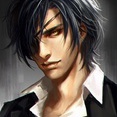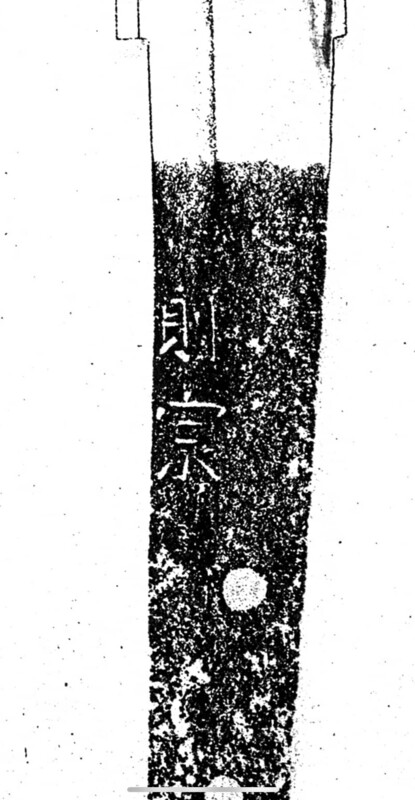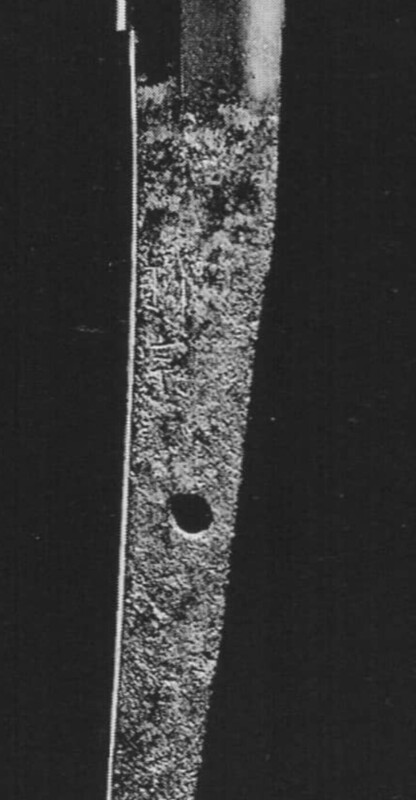-
Posts
1,895 -
Joined
-
Last visited
-
Days Won
20
Content Type
Profiles
Forums
Events
Store
Downloads
Gallery
Everything posted by Gakusee
-
Wrong His sayagaki were faked.
-
I think this is an understatement. Ichimonji Norimune is not just big but it is extremely big. He is the founder of the Ichimonji school ie Fukuoka so this would be as big as it gets in terms of “discovery”. So, yes, if it came from the West or even Japan - it would likely have been tried for papers…… Indeed here we cannot see if behind the suguha kesho polish one can find the kochoji that are expected. What however does not look promising is the mei. The space between the kodachi kanji is too wide and the sizing given the proportions of the nakago do not seem right. Attached are images of genuine Norimune. More compact, tighter together etc. The nakago would have probably been a bit slimmer too….
-
Well done Coden! Excellent achievement. I remember jointly checking out your other tsuba during the 2023 DTI and looking at its original-inspiration progenitor tsuba. This one is even better.
-
Looks like he built a rather valuable and diverse collection spanning the historic development of the Japanese sword.
-
Utsuri: light coloured. Antai (space between habuchi and utsuri): dark
-
Apart from the V&A and BM, the Tower used to have some tachi and katchu (even though the majority are now in the Armoury in Leeds) and also the Wallace Collection should have some Japanese items. The Japanese Gallery in Kensington is a well known swords and prints dealership, Peter Finer sometimes has Japanese swords, etc… You need to plan these things in advance and not post a last-minute request on NMB. Remember - this is the physical world, where appointments and planning are necessary versus the virtual world of insta-posting
-
That is excellent koshirae. Congratulations on the acquisition.
-
May I recommend that perhaps we analyse a bit our likes / dislikes and what draws us to a sword in terms of some principal characteristics: - shape (do we like dainty, elegant swords or large, macho blades with okissaki; what kind of sori; what about niku/ shinogi/ horimono etc) - hamon (quieter vs exuberant, suguha vs midare, nie based vs nioi based, sareru or more shimiba, wider nioiguchi or tigher, presence of hataraki or absence) - jigane (clearer or with utsuri, tight vs larger, jihada - masame/mokume/itame etc etc, do we want lots of konie and chikei or not) - degree of preservation (state of blade, state of nakago eg mei or lack, etc) - other perks and elements that are nice to have (certain certificate level, provenance, koshirae, obvious signs of usage such as tameshimei or kirikomi) Once we are more structured in the approach to what draws us to a sword then we can discuss more pertinently what to do. The recommendation to keep going to Japan to see the most/best is a great one. Failing that, of course for a buyer based in the US working with someone like Fred or Mike or Ray Singer etc would be the way forward at high level.
-
David, And how can “the esteemed Token” provide guidance when Parcelforce or Royal Mail might themselves not be clear on how they apply the rules? And when different texts imply disparate interpretations? For instance the attached document clear mentions swords are “prohibited” while the website (which you have correctly quoted above) contradicts by stipulating that antiques are excluded. So, antiques, if documented for example with a combination of NBTHK certificates or NTHK certificates and a photocopy of a torokusho and clearly described as precious art objects of historic or cultural importance and not to be used as weapons, should in theory be accepted. UK destinations Prohibited Bladed Items cannot be sent. However, other Knives or Blades as defined by s141A Criminal Justice Act 1988 or ‘Bladed Products’ as defined by s41 of the Offensive Weapons Act 2019 can be sent using the Age Verification service. These include but are not limited to any knife or knife blade, including cutlery knives, bread knives, knives that can be used for hobbies and trades (for instance, utility knives and snap-off cutters, gardening, camping, lock knives, bushcraft and farming tools with a blade or any other trade tool that could commonly be described as a knife), butcher knives (including meat cleavers), felling axes and razor blades. Note: this excludes folding pocket knives where the cutting edge of its blade does not exceed 3 inches (7.62cm) or razor blades permanently enclosed in a cartridge or housing where less than 2mm is exposed which can be sent without using Age Verification service. Please note: It is the senders’ responsibility to ensure compliance with the law. The following links to the legislation and guidance may assist but Parcelforce prohibitions and restrictions regarding the sending of bladed items must also be followed: Criminal Justice Act 1988Opens in new window Offensive Weapons Act 2019Opens in new window Statutory guidance: Offensive Weapons Act 2019Opens in new window The following are not prohibited and will instead be treated as Restricted Bladed Items, provided the only intended use is one of the permitted uses listed below: Bladed items that are: commonly used for sporting activities; commonly used for religious ceremonial purposes (must be blunted); sgian dubhs (must be blunted and for ornamental purposes); being sent to a recognised museum; commonly used in historical re-enactment (must be blunted); commonly used in theatrical productions (must be blunted); and antiques. Note: in order to avoid your item being treated as prohibited, in the event of any checks it would be helpful to include supporting documentation to enable us to verify the relevant permitted use listed above. Important: Items intended by the person sending or receiving it to cause injury to a person are always prohibited and will be treated/handled as such regardless of whether or not they fall into one of the permitted uses above. Finally , it is one thing what is legal to be owned (the law) and what a private carrier (Royal Mail and its subsidiary Parcelforce) decides to do. So, theoretically there is the antiques loophole above but one needs to pre-educate Parcelforce, thoroughly (over-)document and rely on everyone in the Parcelforce chain having the same understanding and interpretation…… parcelforce-worldwide-account-our-prohibited-and-restricted-goods.pdf
-
Jussi, we ran the maths on a possible shinsa in Europe or UK in the recent couple of years. Having to subsidise business class travel and hotel costs for the shinsa panel meant we needed to gather hundreds of swords to make it happen. In the end, we could not make it work (as those who could afford or had the volumes for multiple submissions already have their swords papered….)
-

Masamune on Yahoo auctions Japan(Possibly)
Gakusee replied to Ilovekatana's topic in Auctions and Online Sales or Sellers
Yes Jacques, you are right. Not only the handwriting but also some small placement differences of the printed text but also the red seal top right. Frankly, not sure why. -
These events in theory are always worthwhile but very difficult to pull off organisationally, so I always admire and am grateful to the organisers. The Japan Art Expo in Utrecht has proven it but it is difficult to make people attend and travel the distance, let alone bring swords. If one has to fly and transport their swords, people get cautious. If one drives to the destination with their items, it might be easier.
-

Masamune on Yahoo auctions Japan(Possibly)
Gakusee replied to Ilovekatana's topic in Auctions and Online Sales or Sellers
Probably right that it will not shift. It just has too much “top level authority” support underpinning it. The above list misses the Tokugawa Jikki, Tanobe’s sword book and the Kanto Hibisho documentation too. Interestingly, Kunzan sensei comments on the sword being a bit more rustic than usual and that the strong sunagashi could also point to Shizu. So, this “atypical” Masamune that is embedded as Masamune in history might just not qualify to be the pinnacle and epitome which TokuJu symbolises nowadays. -

Masamune on Yahoo auctions Japan(Possibly)
Gakusee replied to Ilovekatana's topic in Auctions and Online Sales or Sellers
-
The issue is getting in touch…. Has he responded to your emails / contacts?
-
ANA and Haneda = trouble and delays in most cases. Inexperienced airport staff and disallowed /prohibited to carry on board by airline. JAL/BA (they operate shared codes and flights) and Narita = OK in most cases (almost always). In almost all cases, if you can ensure an individual transports the items for you, go for that method. Unlimited number of blades allowed on the way out of Japan for export but max 3 on the way into Japan when bringing in. Watch out for value of items, declare them as weapons, be mindful gold is taxable on the way in etc etc etc In short, just deal with an experienced and professional importer. There are several dealers in the U.K. who do this professionally.
-
Two points we need to consider: 1) swords are still “prohibited” (to be sent); 2) while the ban is clear as regards “sending”, it will be useful to understand if “receiving” in their Parcelforce clearance depot will be permitted. That is only pertinent for receiving swords from overseas and in case Parcelforce needs to do the customs clearance (which it usually does and processes import levies). If that is permitted, one can drive to the depot and collect the imported sword. But it needs to be verified.
-
Randell Make sure you spend some quality time with the armours. While Peter Janssen does have several very good / excellent swords, I would say the forte of the museum is armour and related accessories. There are 5-6 daimyo armours which are outstanding. You will know which ones as the light goes off automatically there to preserve the silk/colours. Also, the Maeda and Myochin uchidashi ones towards the middle of the museum are great, the small tea house diorama, etc etc. Not sure which swords will be exhibited, but look out for the various Rai, the excellent Ichimonji, etc swords.
-
Moriyama san, yes, thanks, but actually the year is already specified as 2022 in the middle of the number (04202209)? Is this not a repetition? What you say makes sense and also it indeed takes around 3 months for certificate issuance (submit in September and get the paper in December 2022).
-
Piers - let me double check please. So, from the certificate above I can see that it was submitted in the April 2022 shinsa and the certificate itself was issued in December 2022 (14 Dec Reiwa 4). Am I looking at the wrong photo as I do not think it was issued 3 months ago?
-
A value of a certificate issued by a reputable and trusted organisation in principle (without specifying organisations per se) lies in the implied assurance the reader draws that a panel of knowledgeable experts have examined the item. In most cases, these knowledgeable (usually Japanese) experts are much more adept and skilled than us here in the West and reputationally and empirically they are trusted. If you look at different organisations in Japan, in general they attest slightly different things. But a common denominator seems to be: - the item is authentic - of a certain (old) age - worthy of preservation Therefore to the user, the value lies in the assurance they are not buying eg, a plexiglass armour made yesterday or a gimei sword with blatantly wrong signature or a cast menuki that purports to be Goto yet was made in China. You will need to undertake a further study of the various certificate issuing authorities and I recommend you visit their websites (both Western branches and HQ Japanese branches) and use something like Google Translate to read what their certification actually means. After the initial take, then you ought to look at what it might mean if the certificate also mentions a signature which is on the certified item: - does the authority / panel agree with the signature - does it “authenticate” the signature and accept it or does it not Etc etc. This is where it becomes much more involved and interesting.








